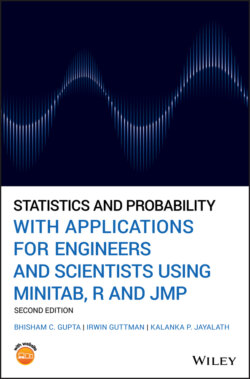Читать книгу Statistics and Probability with Applications for Engineers and Scientists Using MINITAB, R and JMP - Bhisham C. Gupta, Irwin Guttman - Страница 115
3.2 Random Experiments, Sample Spaces, and Events 3.2.1 Random Experiments and Sample Spaces
ОглавлениеInherent in any situation where the theory of probability is applicable is the notion of performing a repetitive operation, that is, performing a trial or experiment that is capable of being repeated over and over “under essentially the same conditions.” A few examples of quite familiar repetitive operations are rolling a die, tossing two coins, drawing five screws “at random” from a box of 100 screws, dealing 13 cards from a thoroughly shuffled deck of playing cards, filling a 12‐oz can with beer by an automatic filling machine, drawing a piece of steel rod, and testing it on a machine until it breaks, firing a rifle at a target 100 yards away, and burning ten 60‐W bulbs with filament of type continuously until they all “expire.”
An important feature of a repetitive operation is illustrated by the repetitive operation of firing a rifle at a 100‐yard target. The shooter either hits the target or misses the target. The possible outcomes “hit” or “miss” are referred to as outcomes of the experiment “firing at a target 100 yards away.” This experiment is sometimes called a random experiment. We will have more discussion of this at a later point. This important feature needs formalizing with the following definition.
Definition 3.2.1 In probability theory, performing a repetitive operation that results in one of the possible outcomes is said to be performing a random experiment.
One of the basic features of repetitive operations or random experiments under specified conditions is that an outcome may vary from trial to trial. This variation leads to the analysis of the possible outcomes that would arise if a trial were performed only once. The set of all possible outcomes under specific conditions if an experiment was performed once is called the sample space of the experiment and is denoted by S. It is convenient to label an outcome in a sample space S by the letter e, and call e a sample space element or simply an element or sample point of the sample space S. The sample space S of such elements or points is generated by the operations or trials of a random experiment. Consider the following examples of elements or sample points that constitute a sample space.
Example 3.2.1 (Rolling a die) If a die is rolled once, the sample space S thus generated consists of six possible outcomes; that is, the die can turn up faces numbered 1, 2, 3, 4, 5, or 6. Thus, in this case,
Example 3.2.2 (Tossing two coins) If two coins are tossed, say a nickel and a dime, and if we designate head and tail on a nickel by H and T, respectively, and head and tail on a dime by h and t, respectively, the sample space S generated by tossing the two coins consists of four possible outcomes. We then have that
As an example, Ht denotes the outcome that the nickel, when tossed ended up showing head, while the dime, when tossed, showed tail.
Example 3.2.3 (Sample space for item drawn using random sampling scheme) The sample space for drawing five screws “at random” from a box of 100 consists of all possible sets of five screws that could be drawn from 100; contains 75,287,520 elements.
Example 3.2.4 (Sample space for playing cards) In dealing 13 cards from a thoroughly shuffled deck of ordinary playing cards, the sample space consists of the 635,013,559,600 possible hands of 13 cards that could be dealt from the 52 cards of an ordinary deck.
The sample spaces for these preceding examples are all finite sample spaces: they contain only a finite number of sample points. A sample space is finite as long as it contains a countable number of elements, no matter how large that number may be. For instance, in Example 3.2.4, the number of elements is very large but countable. Many problems in probability involve infinite sample spaces, that is, sample spaces containing an infinitely large number of elements that are not countable.
Example 3.2.5 (Sample space for reaction times) A chemist studies the reaction time when a catalyst is added to a chemical at a certain temperature. In this experiment, the sample space contains an indefinitely large number of elements when observing the reaction time.
Example 3.2.6 (Sample space for beer refills) The sample space when filling a “12‐oz” can with beer with an automatic filling machine under factory conditions, would contain an indefinitely large number of elements when measuring the fluid content of the filled can.
